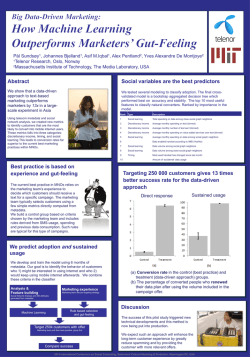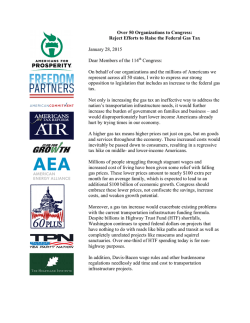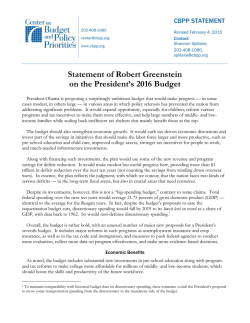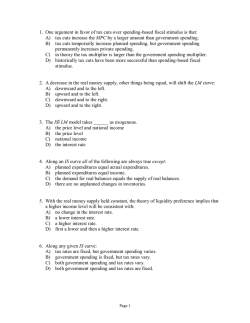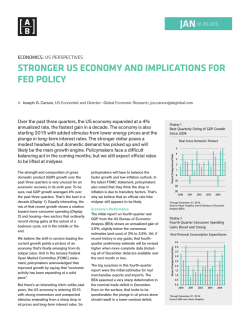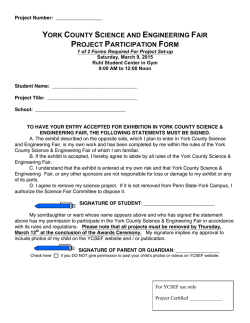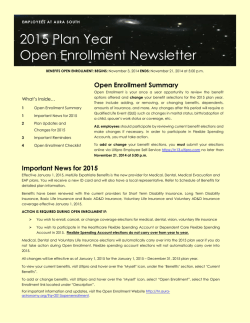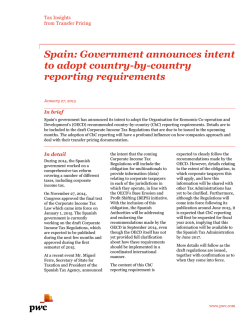
Innovation`s New World Order
strategy+business ISSUE 81 WINTER 2015 THE GLOBAL INNOVATION 1000 Innovation’s New World Order Asia is now the top regional destination for R&D spending, followed by North America and Europe. BY BARRY JARUZELSKI, KEVIN SCHWARTZ, AND VOLKER STA ACK REPRINT 00370 feature innovation 1 1000 Asia is now the top regional destination for R&D spending, followed by North America and Europe. by Barry Jaruzelski, Kevin Schwartz, and Volker Staack feature innovation Innovation’s New World Order Illustration by Martin O’Neill The geographic footprint of innovation is changing dramatically as research and development programs become more global. An overwhelming 94 percent of the world’s largest innovators now conduct elements of their R&D programs abroad, according to the 2015 Global Innovation 1000 study, our annual analysis of corporate R&D spending. These companies are shifting their innovation investment to countries in which their sales and manufacturing are growing fastest, and where they can access the right technical talent. Not surprisingly, innovation spending has boomed in China and India since our 2008 study, when we first charted the global flows of corporate R&D spending. Collectively, in fact, more R&D is now conducted in Asia than in North America or Europe. Perhaps more unexpectedly, innovation spending in the U.S. has held relatively steady as a share of global innovation spending, despite increases in the amount of R&D that U.S. firms conduct in Asia. This is due in part to companies from other countries increasing their R&D activity in the United States; Silicon Valley, in particular, has been a powerful draw. Innovation spending in Europe, in contrast, grew more modestly and unevenly, with some countries, such as France and the U.K., showing net decreases in domestic R&D spending from 2007 to 2015. More European companies are choosing to expand their R&D operations elsewhere, in both low-cost countries in Asia (defined as countries where the average annual engineering salary is less than US$35,000) and high-cost countries such as the United States. 2 feature innovation 3 Kevin Schwartz [email protected] is a principal with PwC US, and leads the firm’s innovation and development consulting services. Based in San Francisco, he focuses on driving enterprise-wide innovation and enabling growth through new products, services, and business model innovations. For leading companies, implementing a global innovation strategy is paying off. We found that firms that favor a more global R&D footprint outperform their less globalized competitors on a variety of financial measures. This is important, because, as in previous years, we found no statistically significant evidence that higher levels of spending guarantee better results (see “The 10 Most Innovative Companies,” page 9). Our refrain has long been that it’s not how much you spend on research and development, but how you spend it. But it’s also where you spend that determines your success — and our 2015 study shows that decisions about R&D location look very different today than they did less than a decade ago (see Exhibit 1). Worldwide, R&D spending by the Global Innovation 1000 companies — the 1,000 public corporations worldwide that spent the most on researching and developing products and services for their markets — rose 5.1 percent to $680 billion in 2015, the strongest increase in the last three years. Companies headquartered in the U.S., Europe, and Japan continued to account for a large majority of innovation spending: 86 percent in 2015 (see “Profiling the Global Innovation 1000,” page 5). But we know that analyzing global innovators based solely on where their headquarters are located doesn’t reveal where the actual work of innovation is being done. To analyze the flows of R&D spending among regions and countries, we researched the innovation activities of 207 companies in 23 countries conducting R&D at 2,041 sites in more than 60 countries (see Methodology, page 15). This sample of major innovators accounts for 71 percent of the total Global Innovation 1000 spending. To describe location and flows of innovation spend- Volker Staack volker.staack@ strategyand.us.pwc.com is a leading practitioner for Strategy&. He is a principal with PwC US. He focuses on engineered products and services, particularly in the automotive and heavy equipment industries, and specializes in strategic product value management, turnarounds, and implementation of global M&A. Also contributing to this article were s+b contributing editor Rob Norton, Strategy& campaign manager Kristen Esfahanian and senior associate Spencer Herbst, and PwC manager Vivek Shrivastava. ing, we use the terms in-country (or in-region) spending, exports, and imports as a convenient shorthand. A multinational that spends a third of its R&D budget outside its headquarters country is thus considered to be exporting 33 percent of its R&D spending. The disadvantage of using this terminology is that the concepts of importing and exporting are antithetical to the concept of a multinational corporation, which by definition conducts business globally rather than nationally. It can also be potentially misleading, in that mergers and acquisitions can alter the export and import numbers even though the location of past innovation activity does not change. Still, this type of analysis provides an accurate gauge of where innovation activity is being conducted around the world, and how corporate management makes R&D investment decisions. It also provides a way to chart the relative gains and losses across countries and regions. As a complement to our study, we asked global innovation executives about both their companies’ experiences with global innovation and their views on successful innovation practice. The 369 respondents to the Web survey represented companies that collectively accounted for more than $106 billion in R&D spending — 16 percent of the Global Innovation 1000 total. We also conducted in-depth interviews with a select group of senior innovation leaders to hear firsthand how the global innovation model has evolved. Given the pervasiveness of globalized innovation and the performance premium that a globalized footprint provides, the benefits for companies are obvious. But executing such a strategy comes with challenges, and a set of best practices has emerged to help innovation leaders manage them. It’s critical that they do so, because the best opportunities are now scattered far and (continued on page 7) strategy+business issue 81 Barry Jaruzelski barry.jaruzelski@ strategyand.us.pwc.com is a thought leader on innovation for Strategy&, PwC’s strategy consulting business. Based in Florham Park, N.J., he is a principal with PwC US. He works with high-tech and industrial clients on corporate and product strategy and the transformation of core innovation processes. He created the Global Innovation 1000 study in 2005, and in 2013 was named one of the “Top 25 Consultants” by Consulting magazine. 1000 In-country R&D spendingIn-Country R&D Spending (which includes domesticIn-Country R&D Spending Domestic and imported R&D and imported R&D) Domestic and imported R&D countries in which for countries in which for for countries in which US$10 billion or more US$10 billion or more was US$10 billion or more spent on R&D in 2015 spent on R&D in 2015 was was spent on R&D in 2015 US$ Billions US$ Billions US$ Billions U.S. $145 it 1: Global Shifts in R&D Spending, Exhibit 1: Global Shifts2007–15 in R&D Spending, 2007–15 Exhibit 1: Global Shifts in R&D Spending, 2007–15 U.S. $109 Corporate R&D Spending China $55 In-Region Corporate Corporate Spending R&DR&D Spending R&D Spending (Domestic and by Headquarters In-Region In-Region R&D Spending R&D Spending by Headquarters by Headquarters Imported) US$ Billions (Domestic and (Domestic and Imported) Imported) US$ Billions Billions US$ US$ Billions North America US$ Billions US$ Billions North America North America Europe Europe Asia Asia Europe Asia U.S. $109 U.S. $109 feature innovation nies headquartered in Companies North America continue to in spend the most oncontinue corporate headquartered North America to spend the most ut where companies spend their R&D money being spentAmerica has spend changed Companies headquartered in companies North continue to spend the most on corporate R&D. But is where their R&D money has changed cally: Asia is now thedramatically: leading region in is innovation spending, and Europe on corporate R&D. But where spend R&D money has changed Asia now thecompanies leading region intheir innovation spending, and Europe ped to third place. The chart at right shows a country-level view. dramatically: isplace. now the in innovation spending,view. and Europe has slipped to Asia third Theleading chart atregion right shows a country-level has slipped to third place. The chart at right shows a country-level view. Japan $40 $200 $200 $200 Japan $40 Japan $40 Japan $50 $200 $200 4 $150 $150 $150 $150 $150 $100 $100 $100 $100 $100 Germany $28 Germany $28 Germany $28 China $25 China $25 China $25 U.K. $23 U.K. $23 U.K. $23 France $20 France $20 France $20 India $13 India $13 India $13 Canada $9 Canada $9 Italy $8 Italy $8 South Korea $7 South Korea $7 Israel $7 Israel $7 2007 2007 2015 2015 2015 2007 2015 Canada $9 2007 2007 Source: Bloomberg data, Capital IQ data, Strategy& analysis Bloomberg data, Capital IQ data, Strategy& analysis Source: Bloomberg data, Capital IQ data, Strategy& analysis 2015 2015 Italy $8 South Korea $7 Israel $7 2007 2007 2007 Germany $32 India $28 U.K. $22 France $16 South Korea $13 Israel $11 Italy $11 Canada $10 2015 2015 2015 Profiling the Global Innovation 1000 T Exhibit A: R&D and Revenue the Great Recession. It also indicated R&D spending in 2015 rose an impressive 5.1 percent from last year. a reversion to the long-term trend of R&D spending growth of 5.4 percent demonstrated over the last 10 years. Revenues for the Global Innova- he companies in the Global tion 1000 would have increased as Innovation 1000 spent US$680 well, had it not been for the effects Indexed to 1998 3.5 R&D Spending 3.0 2.5 billion on R&D in 2015. That repre- of collapsing oil prices on top-line 2.0 sented a 5.1 percent increase from growth in energy firms, which edged 1.5 2014, a year in which R&D spending overall revenue down by 1 percent. grew a meager 1.4 percent. The 2015 This phenomenon also contributed to spending growth marked the larg- a slight rise in R&D intensity, or inno- est year-over-year increase since vation spending as a percentage of 2011 and 2012, when we reported revenue, from 3.5 percent in 2014 to Revenue R&D Spending as a % of Revenue 1.0 2005 2000 2010 2015 Source: Bloomberg data, Capital IQ data, Strategy& analysis Exhibit B: The Top 20 R&D Spenders Although some of their rankings shifted, the 2015 list of the 20 biggest R&D spenders features many of the same names as the previous year’s list (and in 11 cases, as lists from the last decade). However, there were two notable entrants to the top 20: Apple and AstraZeneca. Companies in RED have been among the top 20 R&D spenders every year since 2005. R&D Spending RANK 2015 2014 Company 2015 US$ Billions Headquarters Industry 5.7% Europe Auto Change from 2014 % of Revenue 1 1 Volkswagen $15.3 13% 2 2 Samsung $14.1 5% 7.2% South Korea Computing and Electronics 3 3 Intel $11.5 9% 20.6% North America Computing and Electronics 4 4 Microsoft $11.4 9% 13.1% North America Software and Internet 5 5 Roche $10.8 8% 20.8% Europe Healthcare 6 9 Google $9.8 24% 14.9% North America Software and Internet 7 14 Amazon $9.3 41% 10.4% North America Software and Internet 8 7 Toyota $9.2 1% 3.7% Japan Auto 9 6 Novartis $9.1 –8% 17.3% Europe Healthcare 10 8 Johnson & Johnson $8.5 4% 11.4% North America Healthcare 11 13 Pfizer $8.4 26% 16.9% North America Healthcare 12 12 Daimler $7.6 9% 4.4% Europe Auto 13 11 General Motors $7.4 3% 4.7% North America Auto 14 10 Merck $7.2 –4% 17.0% North America Healthcare 15 15 Ford $6.9 8% 4.8% North America Auto 16 16 Sanofi $6.4 1% 14.1% Europe Healthcare 17 20 Cisco Systems $6.3 6% 13.4% North America Computing and Electronics 18 32 Apple $6.0 35% 3.3% North America Computing and Electronics 19 19 GlaxoSmithKline $5.7 –7% 15.0% Europe Healthcare 20 28 AstraZeneca $5.6 16% 21.4% Europe Healthcare $176.5 9% 8.4% TOP 20 TOTAL Source: Bloomberg data, Capital IQ data, Strategy& analysis strategy+business issue 81 feature innovation 5 above-average catch-up gains after 1000 3.7 percent in 2015. Companies tend to stick with their innovation programs despite cyclical revenue fluctuations: Exhibit C: Spending by Industry, 2015 spending by healthcare companies Healthcare companies continued to narrow the gap with the largest industry spender, computing and electronics. healthcare sector is closing in on the But the biggest movers among Telecom 1.8% Innovation 1000 (see Exhibit A). industries have been software and Consumer 3.0% Volkswagen, Samsung, Intel, Internet companies. The industry Aerospace and Defense 3.3% Microsoft, and Roche led the Global Chemicals and Energy 6.2% increased R&D spending by 27.4 Industrials 11.1% percent between 2014 and 2015. Innovation 1000 in R&D spending, and held the top five positions for the the largest R&D spender by 2019. Other 1.5% paced revenue growth for the Global Software and Internet also had Software and Internet 11.2% second year in a row. Apple joined the the largest average growth of any Auto 16.1% top 20 list at number 18, powered by industry over the last 10 years — 13.2 Healthcare 21.3% its sustained growth. AstraZeneca percent — and passed industrials in Source: Bloomberg data, Capital IQ data, Strategy& analysis was the other newcomer to the list, number one position; if the current trend continues, the industry will be Computing and Electronics 24.5% R&D spending growth has often out- rose 6.0 percent (see Exhibit D). The 2015 to become the fourth-largest industry in terms of R&D spending. the first time Apple has appeared intensity of its competitors in the com- This rank change happened despite on the top 20 spenders list. Still, the puting and electronics industry. the fact that industrials companies company is an efficient and effec- posted the second-largest year- Among industries, the tive innovator: It has the lowest R&D computing and electronics, health- over-year increase, at 8.9 percent, intensity of any company on the top 20 care, and auto sectors continued to and the third-highest 10-year aver- list, spending only 3.3 percent of its spend the most on R&D. In total, they age increase, at 6.3 percent. revenues on R&D, compared with an accounted for 62 percent of total Glob- average of 12.5 percent for the other al Innovation 1000 R&D spending (see companies headquartered in North 19 companies on the list. In addition, Exhibit C). However, R&D spending by America, Europe, and Japan contin- Apple’s R&D intensity is less than computing and electronics companies ued to dominate the Global Innova- one-third the 11.8 percent average fell 0.7 percent in 2015, whereas R&D tion 1000. But their share of R&D feature innovation at number 20 (see Exhibit B). This is From a regional perspective, spending has fallen from 96 percent Exhibit D: Change in R&D Spending by Industry, 2014–15 in 2005 to 86 percent in 2015. North Software and Internet companies increased spending by 27.4 percent — roughly three times the percentage increase of industrials. American companies’ share edged 27.4% 8.9% Industrials Healthcare Aerospace and Defense Auto most, falling from 24 percent to 16 percent of the total. innovators headquartered in other regions, notably in China and the 5.0% “rest of world” category (which in- 4.5% cludes countries such as Brazil, India, and Israel), increased their WEIGHTED AVERAGE: 5.1% Computing and Electronics –0.7% –10.0% and Japanese companies lost the During the last decade, 6.0% Chemicals and Energy –0.1% –2.8% –4.3% 6 European companies’ share was flat; Length of bar = Change in spending from 2014 Height of bar = 2015 R&D spending Software and Internet down from 42 percent to 40 percent; Other Consumer Telecom Source: Bloomberg data, Capital IQ data, Strategy& analysis share of the Global Innovation 1000 spending substantially — from 3 percent in 2005 to 14 percent in 2015. (continued on next page) 6 strategy+business issue 81 feature innovation 7 headquartered outside the region. Such innovation activity in (continued from previous page) Exhibit E: Change in R&D Spending by Region, 2014–15 China and India has been central Companies headquartered in Companies headquartered in China again to Asia’s rise. Between 2007 and these countries now represent showed the strongest percentage increase in spending. 2015, R&D spending in China 227 of the Global Innovation 1000, increased by 120 percent, to $55 compared with 64 companies 10 31.6% billion, making it the second-largyears ago. Companies based in est location for corporate R&D, China, in particular, increased their passing Japan and Germany ($50 spending by 31.6 percent in 2015 (see billion and $32 billion, respectiveExhibit E). And over the last decade, ly). Although the U.S. retains its Chinese companies increased their top position with $145 billion, its R&D spending by more than 3,000 WEIGHTED AVERAGE: lead is narrowing: In 2007, R&D percent. Moreover, as we’ve noted, 5.1% 9.5% in China was 23 percent of the measuring innovation spending by 7.1% U.S. total. In 2015, it amounted where companies are headquartered 4.0% to 38 percent of the U.S. total. as opposed to where the innovation Rest of North China Europe Japan World America China’s imports of R&D work is actually done significantly from multinationals headquarunderstates the major shift of –6.3% tered in other countries were $44 innovation activity to Asia. billion in 2015 — 81 percent of Source: Bloomberg data, Capital IQ data, Strategy& analysis the $55 billion in-country total (see Exhibit 2). That’s up from $25 billion in 2007, when virtually all R&D in China was import(continued from page 3) wide. “One of the lessons learned over the years is that ed, because only one Chinese company was included in innovation does not have borders,” observes Philippe our sample of top innovators that year. By 2015, 11 more Keryer, chief innovation and strategy officer at France- Chinese companies had joined the sample. Together based telecom equipment giant Alcatel-Lucent, which these 12 companies spent $10 billion domestically. The specializes in IP networking, ultra-broadband access, U.S. led in exports of R&D to China in 2015, accountand cloud technology. “And we need to be careful, be- ing for 39 percent of inflow, followed by Japan (20 percause the next generation of disruptive technology will cent) and Germany (10 percent). Our survey respondents cited proximity to a highnot necessarily come from the same place as the last one.” growth market as the top reason for moving R&D to China (71 percent), followed by proximity to key manuThe R&D Boom in Asia The most dramatic change in global flows of innovation facturing sites (59 percent), proximity to key suppliers spending has been Asia’s rise as the number one loca- (54 percent), and lower development costs (53 percent). tion for corporate R&D. In 2015, Asia accounted for 35 “We have to acknowledge that China is the workbench percent of the global total for the 207 largest spenders, of the world,” says Siegfried Russwurm, chief technology surpassing both North America (33 percent) and Eu- officer and member of the managing board at the global rope (28 percent). This is the total of “in-region” R&D industrial and technology company Siemens, headquarspending, including both spending by local companies tered in Germany. “We made a conscious decision that and R&D spending imported from other regions. In we need to be close to this promising market with our 2007, Europe was the leader, followed closely by North product definition, product design, and engineering.” Russwurm notes that typical Western-designed America. In 2007, the majority of R&D spending in Asia, high-end products often don’t resonate in China. “Our North America, and Europe all came from domestic colleagues in China have open access to all the technolfirms (in each region). In 2015, Asia became the only one ogy that Siemens owns, and [they] design products with of the three to see the balance shift. Fifty-two percent distinct functionality as needed for their markets — at of its R&D spending was imported — done by firms a fabulous cost position, using Chinese suppliers, and 1000 Between 2007 and 2015, corporate R&D spending in China increased by 120 percent, to $55 billion, passing spending in Japan and Germany. Exhibit 2: China Attracts Innovation Spending R&D spending in China by companies headquartered in other countries nearly doubled from 2007 to 2015, led by the United States. China’s Imported R&D US$ Billions TOTAL: $44.2 billion $0.9 $3.8 North America $1.8 Europe $2.5 Asia $3.1 Other feature innovation perfectly fitted to China’s needs.” Russwurm says that innovation from Siemens’s Chinese R&D facilities has enabled the company to offer some of these products, such as simpler computerized machine controllers, in Western markets, capturing new market segments at lower price points than many customers would have expected from the company. Chinese firms are now also exporting R&D spending. Although China’s total R&D exports in 2015 were a modest $2.0 billion, some leading Chinese companies have become global brands — and are setting up global R&D operations. Consumer electronics and home appliance company Haier, for example, established an R&D center in Japan after its acquisition of Sanyo’s appliance business from Panasonic in 2011. It has since opened R&D hubs in Germany and the U.S., as its business has grown in Europe and North America. In 2012, Haier acquired New Zealand–based appliance manufacturer Fisher-Paykel, including its product development center for kitchen appliances. Working with Haier’s main innovation center at the firm’s Qingdao headquarters, says Wang Ye, vice president of Haier Appliance Industry Group and general manager of Haier Global R&D, each global R&D center functions as “a platform to exchange resources and to connect with global channels — including more than 200 universities, 100 technology incubators, and thousands of tech companies, and, of course, local governments. All these resources continue to offer ideas and solutions for our end customers.” One example that Wang cites: Haier’s Qingdao innovation headquarters collaborated with the New Zealand center to combine technologies in electric motors and drum washing machines. The resulting product — the Intelius line of premium washing $4.6 Rest of World TOTAL: $24.7 billion $0.4 Other Europe France South Korea $3.8 $1.1 $1.8 Switzerland $2.2 Germany $2.9 Japan $4.9 U.S. $7.6 2007 $9.2 8 $18.2 2015 Note: Totals may not equal sums due to rounding. Source: Bloomberg data, Capital IQ data, Strategy& analysis machines — has become a sales leader in New Zealand and commands 30 percent of China’s market for premium washing machines. The rise of India as an R&D force has also been impressive. Total corporate R&D conducted in India increased 115 percent between 2007 and 2015, to $28 billion. The growth was powered by R&D spending from other countries, which grew 116 percent. India, to 3M, which has been in the top 10 in each of the last six years — proving that innovation executives aren’t impressed only by shiny digital devices, the world’s most innovative futuristic cars, and online dominance. Tesla, which first appeared on this list in 2013 at number nine, now ranks third. Toyota is back for the first time since 2012. Companies in RED have been among the 10 Most Innovative every year since 2010. R&D Spending RANK Company 2015 US$ Bil. 1000 Rank % of Revenue 2014 pple and Google still rule as Next were perennial top 10 mem- 1 1 Apple $6.0 18 3.3% Global Innovation 1000 survey (see bers GE, Microsoft, and IBM. Toyota 2 2 Google $9.8 6 14.9% Exhibit F). This one–two showing rejoined the list, in 10th place, after 3 5 Tesla Motors $0.5 273 14.5% has been consistent since we began dropping off in 2013 and 2014. This is 4 4 Samsung $14.1 2 7.2% asking participants to identify the top the first year that two auto companies 5 3 Amazon $9.3 7 10.4% innovators six years ago. Apple con- were voted most innovative. For the 6 6 3M $1.8 80 5.6% tinues to set new production records sixth year running, no pharmaceuti- 7 7 GE for iPhones and computers, and burst cal company made the top 10, even 8 8 Microsoft into an entirely new market with the though the industry continues to 9 9 debut of the Apple Watch. Meanwhile, be well represented in the Global Google’s paradigm-changing self- Innovation 1000. As in all previous years, the 10 erate buzz, as do its experiments with most innovative companies outper- solar-powered drones for providing formed the 10 biggest R&D spenders Internet services in remote areas. In on revenue growth, EBITDA as a per- August 2015, the company introduced centage of revenue, and market-cap its Alphabet holding company struc- growth (after normalizing for industry ture to better facilitate focus and in- variations) (see Exhibit G). novation across its growing portfolio. Tesla Motors, which first joined Although much remains the innovative list, change may be on the in ninth position and moved up to horizon. Apple’s margin of victory number five last year, jumped to third narrowed in 2015. As high a propor- place in 2015 — just above Samsung, tion as 80 percent of respondents which held its place at number four. named Apple number one in past Tesla introduced a “ludicrous mode” years, but only 62 percent did so this option for its Model S roadster this year — opening the door for new year, enabling it to accelerate from companies to move into top positions, zero to 60 miles per hour in 2.8 sec- or to enter the fray. US$4 billion-plus battery “Gigafactory” will be producing more auto power packs by 2020 than the total world production in 2013. 2.9% 4 13.1% IBM $5.4 26 5.9% Toyota $9.2 8 3.7% Source: Bloomberg data, Capital IQ data, Strategy& 2015 survey data and analysis Exhibit G: Top 10 Innovators vs. Top 10 R&D Spenders On an indexed basis, the top innovators led on all three financial metrics for the sixth straight year. HIGHEST POSSIBLE SCORE: 100 same when it comes to the most the most innovative list in 2013 onds, and announced that its planned 36 NORMALIZED PERFORMANCE OF INDUSTRY PEERS 65 63 63 55 50 53 46 LOWEST POSSIBLE SCORE: 0 SPENDERS feature innovation driving car project continues to gen- 10 11 $4.2 $11.4 INNOVATORS companies, according to our 2015 9 fifth in 2015. The sixth spot again went Exhibit F: The 10 Most Innovative Companies 2015 A Amazon, first voted onto the most innovative list in 2012, placed Revenue Growth 5-yr. CAGR EBITDA as % of Revenue 5-yr. Avg. Source: Bloomberg data, Capital IQ data, Strategy& 2015 survey data and analysis Market Cap Growth 5-yr. CAGR strategy+business issue 81 The 10 Most Innovative Companies 1000 The U.S.: Leading, but Losing Ground The U.S. held its position as the number one location for innovation, with total in-country R&D spending of $145 billion in 2015, despite the fact that U.S.-headquartered companies exported $121 billion in R&D in the same year. Much of this exported R&D went to lower-cost countries, particularly in Asia. India and China led as destinations for U.S. exports, each with 15 percent of the total. This represents a significant change since 2007, when the U.K. was the top destination for U.S. R&D exports. France was also among the top 10 destinations for U.S. exports in 2007, but has since been surpassed by South Korea. A helpful way to visualize how relative advantage has changed between countries from 2007 to 2015 is to look at the change in each country’s total in-country R&D spending compared with that of the United States, which remains the largest location for R&D (see Exhibit 3). Exhibit 3: Relative Spending Index: Gains and Losses, 2007–15 In a comparison of the R&D spending in other countries to the spending in the top destination — the U.S. — the percentage change between 2007 and 2015 reveals where advantage has been gained (Asia) and lost (Europe). In-Country R&D Spending Relative to the U.S. Percentage Change, 2007–15 ADVANTAGE LOST ADVANTAGE GAINED U.S. = 0 China $55 billion in 2015 R&D spending 64% India 61% South Korea Israel 48% 26% EASTERN EUROPE* 15% Italy 5% –7% Japan –14% –16% –29% –41% feature innovation not surprisingly, is the largest global destination for software R&D. Multinationals that have moved R&D to India cite a variety of reasons for the move, and cost is often not the most important. “Our tech center in India gives us an around-the-clock capability to accelerate development work due to the time difference with the U.S.,” says Denise Ramos, chief executive officer of ITT Corporation, a U.S.-based manufacturer of specialty components for the aerospace, transportation, energy, and industrial markets. “The highest priority was access to technical talent that was in close proximity to regional customers. The fact that some of the labor is lower-cost was nice to have, but not a primary driver.” India moved from seventh to fifth among all countries in terms of total in-country R&D in 2015, surpassing the U.K. and France. Elsewhere in Asia, South Korea’s in-country R&D grew 98 percent between 2007 and 2015, moving it into eighth place, ahead of Israel, Italy, and Canada. Japan fell from second to third place, despite a 24 percent growth in in-country R&D between 2007 and 2015. Japan decreased the amount of R&D exported to the U.S., moving it largely to “nearshore,” low-cost China. Japan’s imports of R&D rose 74 percent, mainly as a result of imports from South Korea and Europe. Germany Canada North America Western Europe U.K. Asia France Other * Eastern Europe spending is based on data from Poland, Slovakia, Czech Republic, Croatia, Romania, Lithuania, Hungary, Turkey, Bulgaria, Estonia, Slovenia, Serbia, Latvia, and Russia. Source: Bloomberg data, Capital IQ data, Strategy& analysis The in-country R&D total in the U.S. was supported by a 41 percent increase in R&D spending by U.S. companies from 2007 to 2015 (to $93 billion) — and by a 23 percent rise in R&D imported from other countries, to $53 billion. Over the past decade, some policymakers, analysts, and business leaders have voiced concerns about a “hollowing out” of U.S. industry, fearing that R&D would be exported to low-cost countries in the same way that much of the U.S. manufacturing industry was offshored in the 2000s. And although the United States has seen increased R&D exports, the effect was muted by the rise in imports. The biggest gains came from imports from European companies, which have invested heavily in the U.S. and provided 63 percent of the U.S. total in 2015. R&D imports from 10 the Reagan administration, the U.S. companies — has been pushing for became the first country to offer a tax an overhaul of the U.S. corporate tax credit for R&D spending. But other code in general and for a permanent nations were quick to copy the idea, and enhanced R&D tax credit in par- and many went on to offer far more ticular. Current U.S. policies, accord- attractive and extensive tax benefits. ing to the group’s position statement, A 2013 study by the Organisation for encourage “the migration of research hen innovation leaders Economic Co-operation and Develop- and development activities to other consider where in the world ment (OECD) measured the generosity countries with more predictable, to locate an R&D facility, tax incen- of R&D tax incentives for 31 countries, more favorable tax treatment.” tives are typically less important and found that the U.S. ranked 22nd. by Barry Jaruzelski and Jeffery Jones W than seven other attributes, such as feature innovation 11 Moreover, the U.S. government It is impossible to know how much of U.S. companies’ R&D ex- access to talent, proximity to custom- has often kept corporate America ports might have been avoided if tax ers, market insight, and operating guessing, authorizing the R&D tax incentives had been more generous costs, according to the 2015 Global credit for only a year or two at a time. and certain. But as the globalization Innovation 1000 survey respondents. The U.S. Congress has even let the of R&D continues, and as more coun- At the same time, however, tax deals credit lapse several times, usually tries compete for innovation leader- can have a positive effect at the mar- resurrecting it later and making the ship, it’s a topic well worth revisiting gin. “It’s icing on the cake, but not the benefit retroactive. by U.S. policymakers. primary driver,” says Denise Ramos, CEO of ITT Corporation. Back in 1981, in the early days of The Silicon Valley Tax Directors Group — a trade association of 79 innovation leaders, most of them U.S. Germany, for example, rose 121 percent between 2007 and 2015. Germany is now the leading source of U.S. imported R&D, surpassing Japan, which led by a wide margin in 2007. The surge of U.S. R&D imports from Europe underscores the fact that cost is typically not the main driver in R&D location decisions. After all, the U.S. is a high-cost country for R&D — in many cases it carries higher costs than European countries. (Nor were companies headquartered in other countries coming to the United States for tax benefits; see “Tax Policy: Where the U.S. Is Not Number One.”) European companies instead came to the U.S. for proximity to their markets and operations, for access to talent and technology, and to take advantage of the United States’ culture of innovation — in particular in Silicon Valley. For pharmaceutical companies, for example, one of the attractions of the United States is its extensive and coherent innovation ecosystem, says Mikael Dolsten, president of worldwide research and development at U.S.-based pharma manufacturer Pfizer. “The National Institutes of Health is the largest biomedical institute in the world, and has traditionally provided significant funding,” says Dolsten. “Although that funding has Jeffery Jones is the U.S. R&D tax services practice leader at PwC US. eroded somewhat in recent years, it remains a cornerstone for academic research, and has set a strategic direction for the U.S. There are strong academic laboratories, a vibrant biotech industry, global pharmaceutical companies, and strong engagement from philanthropic organizations and patient foundations.” Adds Russwurm of Siemens: “The U.S. is attractive for global R&D for several reasons other than the proximity to its large and growing market. One is that digital skills are becoming more and more important. You get good results with people who are true digital natives, and there are more of them in the U.S. than anywhere else. Another is the openness of U.S. society toward innovation. If you look at the car industry, for example, autonomous driving is a major area of interest for innovation. The regulatory circumstances and approach to innovation are more favorable in the U.S. than in Europe, and that is a force driving more innovation activity in the United States.” Europe Slipping The hollowing out of innovation capabilities is happening more noticeably in Western Europe, which has seen the steepest fall in R&D activity. Between 2007 and strategy+business issue 81 Tax Policy: Where the U.S. Is Not Number One 1000 Exhibit 4: European Companies Spend Less at Home Companies in Western Europe increased their R&D exports to high-cost countries everywhere — except in Western Europe. This increase in exports outside the region, coupled with a decline in R&D imports (as evidenced by France and Germany, at right), contributed to Europe's loss of R&D investment. European R&D Exported to High-Cost Countries US$ Billions Change in R&D Flows for France and Germany, 2007–15 Imports $30 76% Exports feature innovation 2015, net European exports of R&D to other regions — exports minus imports — grew by 352 percent. At the country level, Germany was Western Europe’s biggest net exporter, followed by Switzerland. France and Sweden, both net R&D importers in 2007, were net exporters in 2015. As a result, Europe’s total in-region R&D spending fell from 35 percent of the world total in 2007 to 28 percent in 2015. Overall, companies in Europe conducted 57 percent of their R&D inside Europe in 2007, but only 48 percent in 2015. The U.S. was the largest export destination, despite having higher engineering direct labor costs than most European countries. Germany — Europe’s biggest economy — is a case in point: In-country R&D spending rose a modest 15 percent between 2007 and 2015. German companies’ R&D exports totaled $35 billion in 2015, which more than doubled their domestic spending. Meanwhile, Germany’s overall R&D imports fell. France’s R&D performance was similar, but even weaker. Total in-country R&D spending in France fell by 21 percent between 2007 and 2015, as French companies’ exports of R&D rose 46 percent and total French imports fell by 21 percent (see Exhibit 4 ). The largest destinations for French R&D exports were the U.S. (28 percent), China (13 percent), Germany (8 percent), and India (7 percent). The R&D portfolio of Western European countries has shifted significantly as a result of these changes. Spending in home countries declined from 32 percent of all European R&D to 29 percent. Western European companies’ spending in nearshore, high-cost European countries fell from 23 percent to 16 percent, while their spending in offshore, high-cost countries, such as the U.S. and Japan, rose 46 percent. Part of the rise in exports of R&D from Europe is due to the M&A activities of European multinationals. When a multinational merges with or acquires another company, it also acquires the company’s R&D personnel and facilities — typically continuing those operations and integrating them into its overall innovation program. After a major acquisition of a U.S. firm, the acquired U.S. R&D activities are counted as exports in our study even though the location of the work has not North America 46% $20 Western Europe $10 Asia –7% Rest of World $0 2007 2015 –21% France Germany Source: Bloomberg data, Capital IQ data, Strategy& analysis 12 changed. Thus the R&D assets included in Fiat’s $4.3 billion acquisition of Chrysler, completed in 2014, or those in Siemens’s recent $7.6 billion purchase of the U.S. oilfield equipment maker Dresser-Rand Group add to the “export” totals. What’s more worrisome for Europe’s overall position in R&D is the decline of inregion R&D spending. Meanwhile, low-cost Eastern European countries increased their imports of R&D by 53 percent between 2007 and 2015 (compared with 15 percent growth for Western European countries), to $14 billion; these countries were led by Russia, Poland, and Romania. Imports from the U.S. made up half the total, and imports from Western Europe made up another 29 percent. If Eastern Europe were ranked as a single country, 12 1000 feature innovation 13 it would be the eighth-largest spender on R&D, roughly equivalent to South Korea. High-cost European countries nevertheless remain a major force in global innovation, with advantages that include proximity to their large market of wealthy consumers, highly talented and skilled workers, and, in many industries, significant public-sector support for R&D — all of which make it appealing to do innovation work in the region. “We’ve seen increasing investment in pharmaceutical R&D in Europe as a result of European Union funding through the Innovative Medicines Initiative,” says Dolsten of Pfizer. “It has fostered industry and academic partnerships, and provided E.U. funding, which the industry has matched. Another attraction is that Europe has a more integrated healthcare system, so there are large clinical databases that help us understand the impact of disease on populations. Some European countries have very sophisticated electronic medical records systems, which enable us to use big data effectively.” Other innovation leaders also cite the availability of sophisticated and deep talent pools in Europe, as well as proximity to its large and wealthy market. Some, however, point to Europe’s relatively restrictive labor laws and trade unions as a disadvantage for conducting R&D, compared with other regions. The Global Footprint Premium Regional shifts aside, one truth remains constant across all geographies and industries: Companies that overweight their R&D spending outside their headquarters country continue to outperform their less globalized competitors. Companies that deployed 60 percent or more of R&D spending abroad in 2015 earned a premium of 30 percent on operating margin and return on assets, and 20 percent on growth in operating income, over their more domestically focused competitors. This finding was similar to the results of our 2008 study, suggesting that there continues to be a payoff from the deployment of capabilities and capacity on a global scale, and greater success in understanding and meeting local market needs. In both this year’s study and our 2008 analysis, companies whose share of R&D assets invested overseas was greater than their share of overseas sales outperformed companies whose corresponding share was lesser in return on assets, operating margin, and total shareholder returns. We also found that companies that allocate a greater share of their R&D spending to lowercost countries outperformed their competitors by 20 percent on gross profit and 10 percent on sales growth. Moreover, companies have become more proficient at managing global innovation networks. In our 2008 study, for example, we found that companies with highly focused footprints (those with the smallest number of global R&D sites, relative to sales) tended to outperform companies with more fragmented global R&D operations consisting of numerous smaller sites. Evidently they found it easier to manage teams in person than via conference or video calls and collaboration tools. In this year’s study, companies with dispersed global R&D operations are performing as well as or better than companies with focused footprints. This suggests that multinationals have become more experienced at coordinating projects across global sites, and that the digital collaboration tools available have improved markedly and companies have become more adept at employing them. These changes afford multinationals the best of both worlds: the ability to locate their R&D facilities close to strategy+business issue 81 Companies that overweight their R&D spending outside their headquarters country continue to outperform their less globalized competitors. The Three Innovation Models are the more important consideration. “Smaller and more dispersed teams can be effective,” he says, “whether it is California for Internet protocol, Israel for cloud, the East Coast of the U.S. or Europe for optics, France for mathematics — or China, which is becoming an important place for innovation, in particular in wireless and optics.” Managing a Dispersed Network Establishing a global R&D model has become a standard requirement for large corporations that want to be competitive in today’s marketplace. But it comes with a unique set of complexities. Our survey respondents cited a variety of challenges in conducting R&D outside their home countries, with “finding and retaining top talent” and “protecting intellectual property” most often named (and most particularly in China). Other challenges included quality and customer focus, risk and project management, and cultural differences. The good news is that leading innovators are finding ways to manage these and other complexities. To ensure the long-term success of a globally dispersed R&D footprint, company leaders should focus on the following imperatives: • Companyleadersmustclearlyarticulate,aspart of the overall business strategy, the role that innovation plays in the company’s mission. How central is innovation to the company’s competitive advantage? • The centrality of innovation in the company’s competitive advantage should inform the organization’s global footprint. In the absence of a holistic view, R&D sites can proliferate as a result of one-off decisions strive to be the first to market 14 As part of our 2015 survey, with breakthrough products and we asked respondents from all services. Market Readers, who tend three types of companies about the to watch their customers and com- challenges they face in implement- n 2007, the Global Innovation 1000 petitors closely, create value by in- ing global innovation models. Most study identified three fundamen- cremental change and capitalizing on reported similar concerns, with a tal kinds of companies, each with its market trends, using a second-mover few key differences: Intellectual own distinct way of managing the strategy to keep risks low. Technology property protection and quality con- R&D process and its relationship Drivers, who leverage their R&D to trol were paramount for Need Seek- to customers and markets. Need propel both breakthrough innovation ers, whereas finding and retaining Seekers, whose strategy is to ascer- and incremental change, develop top talent was of greatest concern tain the needs and desires of con- original products and services via for Market Readers and sumers by engaging them directly, new technology. Technology Drivers. I feature innovation their markets and the ability to access the best talent at optimal cost levels, all without compromising efficiency. On average, the 207 companies in our global footprint sample export R&D to about six countries, and the figure hasn’t changed much since 2007. When we ranked companies in quartiles based on their degree of R&D globalization, companies in the top quartile increased the number of countries to which they export R&D by just 7 percent, from an average of 13.5 in 2007 to an average of 14.5 in 2015. The companies in the bottom quartile increased this number by 67 percent, from 1.0 countries on average to 1.7. When we looked by region, U.S. companies reduced the number of countries to which they export R&D modestly, while the average number for European companies increased moderately. Among industries, the average number of countries to which companies export R&D increased the most in the auto sector. Both models of globalized innovation — a limited number of more concentrated R&D facilities, and widely dispersed operations — can be effective. And different companies have different preferences. AlcatelLucent, for example, finds that a smaller number of R&D sites is more efficient for development activities. “In development, there is always a trade-off between localization and complexity,” says Keryer, the company’s chief innovation and strategy officer. “As part of our current corporate strategy, we are deemphasizing subscale development sites to create more efficiency, and are concentrating on a set of anchor points — big and diverse development centers.” For research and innovation, on the other hand, Keryer states that talent pools 14 A s it has in each of the past 10 editions of the Global In- onward will not always align with in the industrials and software and previously published figures for the Internet sectors. The total number of 2005 through 2012 studies. companies for which we assessed the For each of the top 1,000 com- feature innovation panies, we obtained from Bloomberg countries was 207, reflecting overlap novation 1000, this year Strategy&, and Capital IQ the key financial met- in the top 100 and the five selected PwC’s strategy consulting business, rics for 2010 through 2015, including industries. These 207 companies are identified the 1,000 public companies sales, gross profit, operating profit, headquartered in 23 countries and around the world that spent the most net profit, historical R&D expendi- conduct R&D activities at 2,041 R&D on R&D during the last fiscal year, tures, and market capitalization. All sites in more than 60 countries. as of June 30, 2015. To be included, sales and R&D expenditure figures companies had to make their R&D in foreign currencies were converted were not publicly available, we spending numbers public. Subsidiar- into U.S. dollars according to an collected data on the location of R&D ies that were more than 50 percent average of the exchange rate over facilities, the product segments owned by a single corporate parent the relevant period; for data on share each facility supports, the year each during the period were excluded if prices, we used the exchange rate on facility was established, the number their financial results were included the last day of the period. of people each facility employs, sales in the parent company’s financials. All companies were coded into When geographic breakdowns by product segment, and global The Global Innovation 1000 com- one of nine industry sectors (or distribution of sales. This data was panies collectively account for 40 “other”) according to Bloomberg’s used to allocate total R&D dollars percent of the world’s R&D spending, industry designations, and into one of from all sources, including corporate five regional designations, as deterand government sources. 15 distribution of R&D spending across In 2013, Strategy& made some mined by their reported headquarters to the countries where facilities were located. Finally, to understand the ways locations. To enable meaningful com- in which global R&D is and will be adjustments to the data collection parisons across industries, the R&D conducted at companies across mul- process in order to gain a more spending levels and financial perfor- tiple industries, Strategy& conducted accurate and complete picture of mance metrics of each company were an online survey of 369 innova- innovation spending. In prior years, indexed against the average values in tion leaders around the world. The both capitalized and amortized R&D its own industry. companies participating represented expenditures were excluded. Starting To understand the global distri- more than US$106 billion in R&D in 2013, we included the most recent bution of R&D spending, the drivers spending, or 16 percent of this year’s fiscal year’s amortization of capital- of that distribution, and how the dis- total Global Innovation 1000 R&D ized R&D expenditures for relevant tribution affects the performance of spending, all nine of the industry sec- companies in calculating the total individual companies, we researched tors, and all five geographic regions. R&D investment, while continuing to the global R&D footprint of the top exclude any non-amortized capital- 100 companies in terms of their 2015 ized costs. We have now applied this R&D spending, plus the top 50 com- methodology to all previous years’ panies in the largest three industries data; as a result, historical data (auto, healthcare, and computing and referenced in the studies from 2014 electronics) and the top 20 companies strategy+business issue 81 Methodology 1000 encourages collaboration among centers worldwide. Specifically, aligning the intangibles of culture — such as risk, creativity, and openness — is critical to success when R&D activities are dispersed globally. As companies further develop and optimize their global innovation networks, they will continue to tap into more diverse global talent pools, a wider knowledge base, and deeper insights into growing markets. With the right implementation, the globalization of R&D will benefit the search for breakthrough innovations, and enable companies to make bigger-bet portfolio choices than they have in the past. + feature innovation and acquisitions and lead to a loss of focus. Companies should also consider the specific needs of each phase of the innovation life cycle. For example, in the idea-generation phase, companies may benefit from setting up smaller, more agile teams where the top talent is located. For product development, larger centers can take advantage of scale and lean principles. • Companies need to define the geographic markets and the customers within those markets that are central to the company’s growth strategy, and then determine where R&D resources need to reside so the company can best understand and serve those markets. Different types of companies may have different approaches (see “The Three Innovation Models,” page 14). For Need Seekers, for example, the key consideration may be locating R&D facilities as close to customers as possible, whereas Market Readers, as second movers, may have more flexibility to base location decisions on cost. Technology Drivers may need to keep R&D more centralized to maintain their focus on technological breakthroughs. • To ensure operational excellence, leaders must create clear missions, roles, and lines of authority to align the dispersed R&D sites with the company’s innovation strategy. Here, leadership needs to invest in the digital tools and related processes that have enabled the best companies to manage such areas as resource deployment, project collaboration, project green-lighting, portfolio ownership, strategic and operating metrics, and transparency mechanisms across a global network. • Companieshavetocreateaglobaltalentmanagement strategy. Increasingly, the people with the skills that companies need are going to be found outside the Western countries where management may have looked most frequently in the past. Companies need common standards for talent development and retention that can be applied at each of their global centers. They should also rotate their top engineering talent, to give future R&D leaders a more global perspective and understanding of the company’s innovation capabilities. • Companyleadersmustfosteracorporateculture that supports the company’s innovation strategy and Reprint No. 00370 Resources Bill Fischer, Umberto Lago, and Fang Liu, “The Haier Road to Growth,” s+b, Apr. 27, 2015: Chinese appliance maker Haier has built the capabilities to rapidly innovate new products to meet consumer needs both at home and abroad. 16 Barry Jaruzelski, “Why Silicon Valley’s Success Is So Hard to Replicate,” Scientific American, Mar. 14, 2014: Further analysis of the themes reported in the 2012 Strategy& white paper “The Culture of Innovation: What Makes San Francisco Bay Area Companies Different?” Dominique Jolly, Bruce McKern, and George Yip, “The Next Innovation Opportunity in China,” s+b, Autumn 2015: Multinationals have shifted their R&D focus in China from cost savings to market proximity — and, increasingly, to knowledge-based research. For links to all previous Global Innovation 1000 studies from 2005 to 2014 (including our 2008 analysis of global R&D flows, “Beyond Borders”), as well as videos, infographics, and other articles, see strategyand.pwc.com/innovation1000. Strategy&’s online Innovation Strategy Profiler, strategyand.pwc.com/ innovation-profiler: Evaluate your company’s R&D strategy and the capabilities it requires. More thought leadership on this topic: strategy-business.com/innovation 16 strategy+business magazine is published by certain member firms of the PwC network. To subscribe, visit strategy-business.com or call 1-855-869-4862. • strategy-business.com • facebook.com/strategybusiness • linkedin.com/company/strategy-business • twitter.com/stratandbiz Articles published in strategy+business do not necessarily represent the views of the member firms of the PwC network. Reviews and mentions of publications, products, or services do not constitute endorsement or recommendation for purchase. © 2015 PwC. All rights reserved. PwC refers to the PwC network and/or one or more of its member firms, each of which is a separate legal entity. Please see www.pwc.com/structure for further details. Mentions of Strategy& refer to the global team of practical strategists that is integrated within the PwC network of firms. For more about Strategy&, see www.strategyand.pwc.com. No reproduction is permitted in whole or part without written permission of PwC. “strategy+business” is a trademark of PwC.
© Copyright 2026
